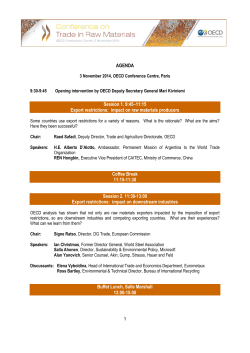
How to Boost Canada`s Innovation Ranking
19 Averting the New Mediocrity: How to Boost Canada’s Innovation Ranking Kevin Lynch Despite having a number of strong innovation precursors—a highly educated general population, generous research and development tax incentives, competitive corporate taxes and relatively low capital gains taxes, Canada is an OECD innovation laggard. How can we build on those fundamentals and stake a claim on the expanding global innovation map? The battle begins with knowledge. T he IMF warns of a “new mediocre” in many OECD countries, including Canada, with significant slowing in our long-term growth potential. The culprits: the double whammy of demographics (an aging population) and productivity (declining growth rates), exacerbated by shifting global markets, rising fiscal burdens and environmental challenges. While mediocre growth in the future is not preordained, it will be our destiny unless we tackle the structural problems that underlie it rather than waiting for a cyclical rebound. And innovation is an underappreciated part of both the problem and the solution. It is time to re-assess what we know, what we don’t know and what we need to know about the drivers of innovation. With technology poised for a new inflection point, and innovation increasingly cited as central to fuelling productivity growth, particularly in high-income countries, the OECD has launched a top-tobottom re-appraisal and renewal of its 2010 Innovation Strategy. This is very timely, with an impending burst of “disruptive technological change”, and very opportune for Canada, an innovation laggard, to learn from such cross-country research and suc- cessful innovation experiences in other economies. were identified in the seminal 2010 OECD Innovation Strategy: The OECD innovation strategy renewal provides an excellent occasion for stock-taking of what we believe and what we actually know about the links between innovation and growth, and how to influence and improve innovation performance. All this reflects the strength of the OECD, which is its duality: on the one hand, a strong multi-disciplinary, multi-jurisdictional, statistical and research institution, and on the other, a unique convening capacity to “test” policy analyses and share policy experiences across the 34 countries that make up the organization. The multi-country nature of the analyses and the reality checks make the OECD a great source of applied policy “do’s and dont’s” for both governments and private sectors. The increasing focus on innovation at the OECD today, given the “growth imperatives” we all face in our respective countries, is simply good news for policy makers, policy analysts, and private sector leaders. • T heroleofpeopleindriving innovation A “back to the future” starting point is to return to the five core elements for sustained innovation performance that • T heroleofframeworkconditions in supporting innovation • T heroleofknowledgecreation and dissemination policies in nurturing innovation • T heroleofmeasurement,and governance, in managing and sustaining innovation • T heroleofinnovationintackling health, education and social challenges As Apple’s Steve Jobs said in 2011: “Technology alone is not enough—it’s technology married with liberal arts, married with the humanities, that yields us the result that makes our heart sing.” This suggests that innovation is a bit more complex than simply tax incentives and venture capital. May/June 2015 20 The revised OECD analytical framework for economic growth (Figure 1.1) sets out four proximate sources of growth: labour; tangible capital; knowledge based capital; and, multifactor productivity. It assigns a more pivotal and explicit role to innovation, both through “multi-factor” productivity and “knowledge-based” capital, which is now treated separately from tangible capital. A number of questions leap to mind in examining the core innovation elements and this revised growth framework. Most fundamentally, is this framework still robust given recent experiences and new research in innovation, including cross-country and cross-sectoral differences? More specifically, do we ascribe too much to policy drivers and too little to contextual factors in a world where entrepreneurs drive disruptive innovation through start-ups and where innovation successes seem more regionally than nationally based? And, in a related vein, do we have the “right mix” of macro conditions and micro enablers? Timing also matters as innovation itself appears poised for a new cycle of disruption. The consulting firm McKinsey & Company has compiled Is the US an innovation powerhouse, or is it specific regions such as Silicon Valley, Seattle, Boston and New York City? And if it is the latter, as it appears to be in the US and elsewhere, then there must be a set of factors beyond national policies that are also relevant to the success of innovation ecosystems. a list of the “top 10 disruptors” (Figure 1.2), which range from advanced robotics to cloud computing to nextgeneration genomics. The OECD uses the “Internet of Things” as an example of incipient disruptive innovations as technology moves to a new inflection point (Figure 1.3). It underscores the convergence across scientific fields that is inherent to many of the forthcoming disruptive technologies and the complexity of the connectivities. And a recent innovation study by CITI highlights the unprecedented pace of dissemination of new innovations (Figure 1.4). D rawing on his research for his bestselling book The Innovators, Walter Isaacson stresses that most innovation is a collaborative process, coming “from teams more often than from the light bulb moments of lone geniuses,” and employing diverse skills as “the most productive teams were those that brought together people with a wide array of specialities.” As Apple’s Steve Jobs said in 2011: “Technology alone is not enough—it’s technology married with liberal arts, married with the humanities, that yields us the result that makes our heart sing.” This suggests that innovation is a bit more complex than simply tax incentives and venture capital. The Isaacson narrative also stresses the role of “communities” in fostering and driving innovation, and cautions about national “averages”. In other words, is the US an innovation powerhouse, or is it specific regions such as Silicon Valley, Seattle, Boston and New York City? And if it is the latter, as it appears to be in the US and elsewhere, then there must be a set of factors beyond national policies that are also relevant to the success of Figure 1.1: A Simplified Framework to Analyse Economic Growth Proximate Sources Underlying Factors Markets, Institutions and Policies Labour Population growth, labour force participation, investment in human capital, other factors Labour market policies, education policies, social policies, etc Tangible Capital Investment in tangible capital; firm entry and exit, changes in market shares, embodied technological progress Macro-economic policy, investment policy, financial markets, etc Knowledge Based Capital Investment in intangible capital; firm entry and exit, changes in market shares Investment policies, framework policies, product market competition Multi-factor Productivity Growth Non-technological innovation, efficiency improvements, other factors Innovation policies, entrepreneurship policies, other Economic Growth Source: OECD Policy 21 innovation ecosystems. Interesting research is underway by the OECD in this regard, examining what they call “place-based innovation dynamics.” A nother issue is “shorttermism” and its impact, either intended or unintended, on both the quantity and type of corporate investments in research and development and innovation. Research and innovation investments, by their very nature, tend to be longer term and uncertain while markets are focusing more and more intensively on short-term results and certainty. How is this dichotomy affecting corporate behaviour with respect to research and innovation? Does it lead to less investment spend- Figure 1.2: McKinsey’s Top 10 “Disruptors” Advanced oil and gas exploration and recovery Cloud technology Energy storage Automation of knowledge work The Internet of things Next-generation genomics Autonomous and nearautonomous vehicles 3D printing Mobile Internet Advanced Robotics Source: McKinsey Figure 1.3: Main Elements of the Internet Cloud Data Sensors Actuators Machine Learning W hat about Canadian performance on innovation? Quite frankly, the results are disappointing. Despite having a number of strong innovation precursors—a highly educated general population, very generous research and development tax incentives, competitive corporate taxes (well below the US) and relatively low capital gains taxes (slightly above the US), Canada is an OECD innovation laggard. Autonomous Machines and Systems Source: OECD Figure 1.4: Time to Reach 50 Million Users of Things 75 Years Radio 38 Years TV 13 Years Internet 4 Years Facebook 3.5 Years 35 Days Angry Birds 0 Source: CITI Digital Strategy Team 50 Despite having a number of strong innovation precursors—a highly educated general population, very generous research and development tax incentives, competitive corporate taxes (well below the US) and relatively low capital gains taxes (slightly above the US), Canada is an OECD innovation laggard. M2M Remote Control Telephone ing on research and innovation, shift the nature of such spending toward more incremental research and innovation, or outsource research and innovation to third parties directly (i.e. fund defined research in universities) and indirectly (i.e. purchasing research and innovation through acquisitions of companies), or some combination of these elements? And, is the shift to “mission-driven research” by many governments driven by effectiveness or short termism? 100 While Canada’s public investment in R&D in higher education (HERD) is still in the top 10 of OECD countries, although it has fallen over the last decade, we are anything but a global powerhouse in private sector research and innovation performance. The numbers tell the story: we are ranked 26th in the world on innovation capacity by the World Economic May/June 2015 22 Forum (Figure 2a). We are ranked 22nd for private sector spending on R&D by the OECD (Figure 2b), spending less than half that of US firms on a comparable basis. We are ranked 17th in the world for private sector productivity by the OECD (Figure 2c), with Canada’s business productivity 30 per cent below that of the US (Figure 2c). The WEF now ranks Canada 15th for global competitiveness and cites poor innovation and research performance as major factors. Canada also shows lagging results in terms of knowledge transfer from universities measured by indicators such as licensing agreements and spin offs. And Canada’s performance in employing STEM (Science, Technology, Engineering and Math) graduates in the labour force, particularly in manufacturing, is low. Not a pretty picture. So, in creating effective innovation ecosystems; while Canada does “the macro” rather well, it comes up short on “the micro.” According to the OECD, getting the “macro conditions” right is now viewed as a necessary, but not a sufficient condition, for sustained innovation success. I n the Canadian context: there is little in the way of a national innovation strategy; there is inadequate competition in many sectors; there is a lack of a global orientation in several innovation-intensive sectors; there is little focus on entrepreneurship in our higher education institutions; and while we spawn exceptional innovators, there is an innovation gap in most sectors between the best-in-class and the class average that is large and static. With respect to public support for research and innovation, there is a marked distinction between “handsoff supports”—indirect and passive, and “hands-on supports”—direct and competitive (either to sectoral collaborations or individual firms). Canada has, more than most countries, opted for indirect and passive research and development support, largely delivered through tax support, on the belief that Canadian governments have not been particularly good at picking winners. But this analysis and perspective are related more to firms and products rather than sectors and technologies—and DARPA (Defence Advanced Research Projects Agency) examples in the US point, anecdotally at least, to a more nuanced approach of both indirect-passive and direct-competitive systems of support. Strategic procurement by government that targets, on a competitive basis, new products and services Figures 2a, 2b and 2c: Canada’s Private Sector Innovation Capacity Ranking, Canada’s Business Spending on R&D (BERD) Ranking and Canada’s Innovation Ranking Canada is ranked 26th by WEF on private sector capacity for innovation—a major factor in our overall declining competitiveness Switzerland United States Israel Germany Finland Sweden Japan Denmark Luxemborg United Kingdom Netherlands Qatar Malaysia Belgium New Zealand Norway Ireland Singapore Austria Puerto Rico France Indonesia Taiwan, China Korea, Rep. UAE Canada Canadian business spending on R&D ranks 22nd among OECD countries (% of GDP) 5.9 Israel 5.9 Korea 5.8 Finland 5.6 Japan 5.6 Sweden 5.5 Switzerland 5.4 5.3 Denmark 5.3 Germany 5.3 United States 5.2 Austria 5.2 Slovenia 5.2 5.2 Iceland 5.1 Estonia 5.0 France 5.0 China 5.0 Belgium 5.0 4.9 Australia 4.8 Ireland 4.8 Czech Republic 4.8 4.7 United Kingdom Luxembourg 4.7 Canada 4.6 Source: World Economic Forum Policy Canadian business productivity is ranked 17th among OECD countries— almost 30% lower productivity levels than US business 124 123 115 109 97 89 89 89 88 85 85 83 83 82 82 81 81 80 71 70 70 3.5 Luxembourg Norway 3.1 United States 2.7 2.6 Ireland 2.3 Belgium 2.1 Australia 2.1 Switzerland 1.9 Sweden 1.9 France 1.9 Denmark 1.8 Austria 1.6 Spain 1.5 Netherlands 1.4 Finland 1.4 Italy 1.4 Germany 1.3 Canada 1.2 United Kingdom 1.1 Iceland 1.1 Greece 1.0 Japan 0.9 Source: OECD Source: OECD 23 by “young firms”, has been shown to be effective in Scandinavia, Israel and parts of the US. OECD analysis across sectors, countries and technologies on the “right” balance of support types suggests that too great a reliance on tax support (i.e. indirect and passive) is less efficient and effective, particularly for start-ups and “growth gazelles.” On the crucial role of talent in driving research and innovation, which everyone accepts, how should we better integrate entrepreneurship and creativity into our models of higher education, encourage cross-discipline team building, and replace the explicit and implicit stigma of failure with more learning support for risk management (not aversion) and resiliency. Drawing on Harvard Business School research, Professor Bill Sahlman stresses the crucial role of entrepreneurship in the innovation process. He believes entrepreneurship is not innate, but can be taught and untaught. The importance of failure in achieving success is critical, and it is the team, and not a single idea, that is key to enduring success. More than one hundred US universities, according to the National Science Foundation, have now introduced broad based entrepreneurship courses into their curriculum. We can clearly do much better in Canada, and the University of Waterloo provides an excellent example. W e also need a better understanding of innovation and productivity behaviour at the level of the firm. Here, cross-country comparisons can be very useful. OECD research shows a considerable gap between average firm innovation performance and best firm performance across sectors in the United States, and anecdotal evidence would suggest the gaps are larger and more durable in Canada. This lack of convergence suggests aggregate innovation and productivity outcomes can be improved by encouraging both new innovations and convergence to best-in-class existing innovations. Emerging research, particularly in the United States, suggests different organizational behaviour with respect to innovation in startup (young) firms versus established (older) firms, and changing innovation behaviour within older firms. Going forward, what areas of analysis by the OECD and others on innovation performance would particularly help Canadian governments, universities and the private sector to improve innovation performance? • T he measurement of innovation. OECD has been a real leader in consistent cross country measurement of research and development, disaggregated by private sector, higher education and government, and this has permitted valuable benchmarking across categories and countries, improving policy analysis and corporate understanding. We need a similar effort on the innovation side, which may be even more complex to do quantitatively, but equally necessary. It is a lot easier to manage things that you can measure and compare. • U nderstanding disruption, building adaptation and resiliency. Disruptive innovation, by definition, impacts firms, workers and consumers, and generates churn and change. It also, by definition, creates micro winners and losers at the same time as it creates macro gains. Maximizing the upside of disruptive innovations and minimizing the downside requires building flexibility into labour and product markets, and enhancing adaptability amongst workers and business leaders. • T he challenge of short-termism. Basic to economics is that incentives matter, and a strong weighting to short-term results will have long term consequences that may not all be intended. It would be timely to have cross country comparative research and analysis on whether and how the “tyranny of short termism” in business decision-making, as eloquently coined by McKinsey’s Global Head Dominic Barton (a Canadian), impacts business research and innovation investment decisions, and whether these impacts are benign or otherwise. • Innovation in the public sector. While one tends to focus on wonderful private sector examples of innovation, there are lots of untapped old problems and new opportunities in the application of innovation to government operations, to the provision of health care and to the process of education. It would be immensely helpful to analyze the state of innovation in these three sectors across OECD countries, share cross country innovation successes, and provide some analytic guidance. All this has to be anchored in the reality of a world facing disruptive change across countries, sectors and professions. Is our economy sufficiently adaptable to handle this pace and scale of change without significant adjustment challenges? Can we manage issues of public trust and social license in the face of such change? Will disruptive innovation exacerbate income inequality in the absence of foresight planning on needed skills and required retraining? What is the appropriate role of government in supporting the research capacity to be a disruptor and the adjustment capacity to be an early adapter in the face of disruptions? How well we answer these questions will shape our economies and societies well into the future. Contributing Writer Kevin Lynch, Vice-Chair of BMO Financial Group, is a former clerk of the Privy Council. He is also Chair of the Board of Governors of the University of Waterloo, and Chancellor of University King’s College in Halifax. May/June 2015
© Copyright 2025









